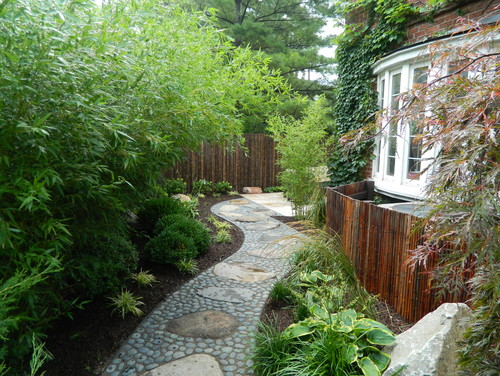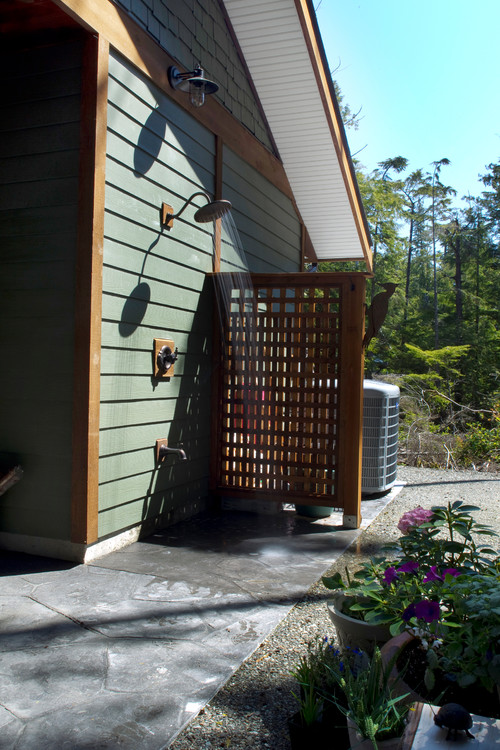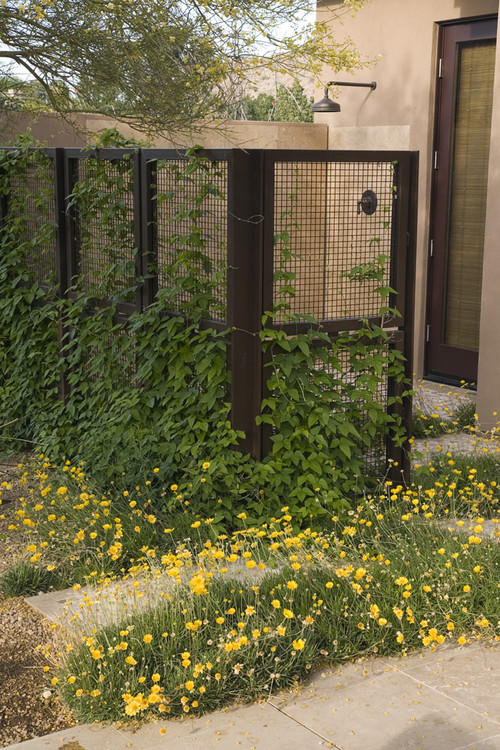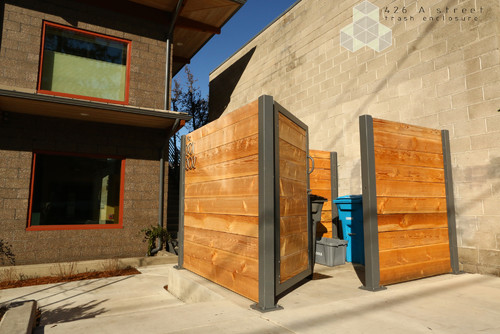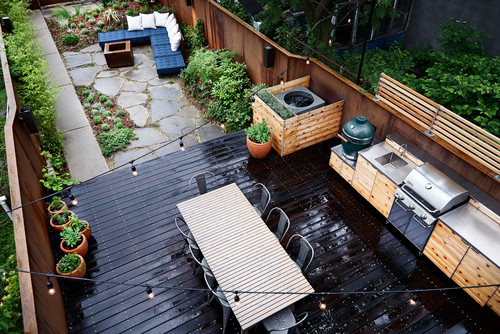How To Hide Air Conditioner Unit Outside + Trash Cans {Guide}

There’s no need to have an eyesore in the backyard, but even the best plans often overlook concealing air conditioners and trash cans from view.
Or, perhaps air conditioning is a new feature in your home and now you need to figure out how to hide that unsightly outdoor unit.
We’ll address how to conceal air conditioners primarily because they have more specialized needs, but keep in mind that similar strategies can be implemented for trash cans. The good news is that the solutions can be both easy and inexpensive.
What Is the Outdoor Air Conditioning Unit For?
Understanding what the outdoor unit of your central air conditioning system does helps when considering concealment strategies. This square or rectangular device is actually a condenser unit that has a compressor, cooling fins and a fan. When in action, it generates a lot of heat because its job is to suck air from the outside into an evaporator where the air is cooled and filtered before entering the house. Your central air conditioning will work harder than necessary (using more precious energy) if conditions outside block needed air flow.
If you’re the position to decide where to put this unit, always opt for the spot in your yard that receives the most shade.
Resist the Urge to Cover AC Units
Cloth and vinyl covers are available to conceal air conditioning condenser units but, usually, they’re still eyesores and don’t blend well into surroundings. These covers limit ventilation so you’re also creating a hassle for yourself. Every time you turn on the air conditioning, you’ll need to remove the cover beforehand otherwise the risk of damaging the compressor is high as the unit struggles to suck in air.
There Must Be Sufficient Ventilation
Most air conditioning condenser units require 2-3 feet of clear space surrounding them in order to ensure proper ventilation. Check your manual to verify what yours requires.
Ventilation is critical especially for homeowners that have gone to the expense of purchasing energy efficient central heating and air. Poor ventilation, as we’ve mentioned already, causes units to work harder and consume more energy than necessary—which defeats the purpose of buying energy efficient to begin with.
Space left above the unit should range about 5-6 feet. Air conditioning units generate heat that needs to dissipate into the environment. Plus, sucking in air that’s hotter than necessary creates extra work for your system.
Make it Accessible
Every once in a while, air conditioners need to be serviced. Make sure that you leave enough room for a tech to access and work around the unit when necessary.
It’s a good idea to enlist the help of a professional as a part of a spring cleaning routine to check coolant levels and make sure the air conditioner is cooling as it should. But what you can do is use a very soft brush to vacuum the delicate little fins (they look like small vents) around the sides of the unit as throughout the season they can collect things like dirt, dead leaves and dandelion cotton that impede air flow. Beyond this simple task, use your manual to open up the unit for further cleaning of both the evaporator and the condenser. Or, leave it to a professional… he or she is likely going to need to check coolant levels anyway.
Monitor Nearby Irrigation
Rainwater might be inevitable, but make sure to keep irrigation from blasting your condenser unit to prevent unnecessary corrosion and an unintentionally high water bill.
Hide with Simple Fencing
Fencing need not be boring. Consider surrounding trash cans and air conditioners with a lattice painted the same color as your house, a custom piece or a pre-made, flexible bamboo fence. Both styles are sold at big retailers such as Home Depot, often times in multiple colors.
Keep in mind the fence doesn’t have to completely enclose an eyesore. Depending on how and from where people view your yard, a little wall may do the trick. This example happens to serve double-duty by also acting as a privacy screen for an outdoor shower.
We’ve managed to camouflage our trash cans with a natural wall of tall and dense rosemary in a raised planter bed that we trim like a hedge when necessary. The benefit to a one-wall strategy is easy accessibility to what’s behind it.
If the wall itself doesn’t blend in, train vines to climb it. Choose a blooming vine to add color.
Fully Conceal with Tall Walls and Gates
This strategy works best for trash cans. Tall fences also allow storage of tall garden tools, surf boards and more. Check local building regulations regarding allowable fence height in your neighborhood as maximum height is usually 6-8 feet tall.
Opt for Clever Plant Design
Get creative with how you position plants to shift focus away from unsightly spots in the yard. Remember, this strategy is often used to make small spaces appear larger than they really are.
Plants with large leaves tend to draw attention while plants with finer leaves blend into the rest of the yard. Experts suggest clustering plants with fine leaves around air conditioners. Ornamental grasses tend to work well as they grow into a confined shape, with some tall enough to shield eyesores. If you have space nearby, cluster some showy tropical plants there to draw the eye away from the grasses and unit.
Keep in mind that some plants won’t tolerate the heat generated by the unit, even from a few feet away. And, because these units are often in shady spots, you may need to consider plants with low sunlight needs.
We also love how this design team softened the fence around the air conditioner with a planter full of greenery. It probably also prevents guests from leaning on the fence and peeking into the unit. With the outdoor kitchen nearby, what a fantastic place to grow herbs.
Think Storage Area
I didn’t really “get it” at the time but our landscape designer created a gated storage area around our air conditioning unit to completely hide it while providing a hidden space to store bikes, patio cushion covers, unused planters and more that would otherwise be scattered around the yard.
Keep the Area Debris Free
Dirt in nearby planters should be held down in order to prevent it from blowing into the condenser. Experts suggest large mulch—small mulch is often too lightweight—or large rocks to hold it down if it’s not already covered with plants and ground cover. Any debris that happens to fall on to the unit during a storm should also be removed.
Your Turn…
What are your tips for hiding eyesores in the yard?
